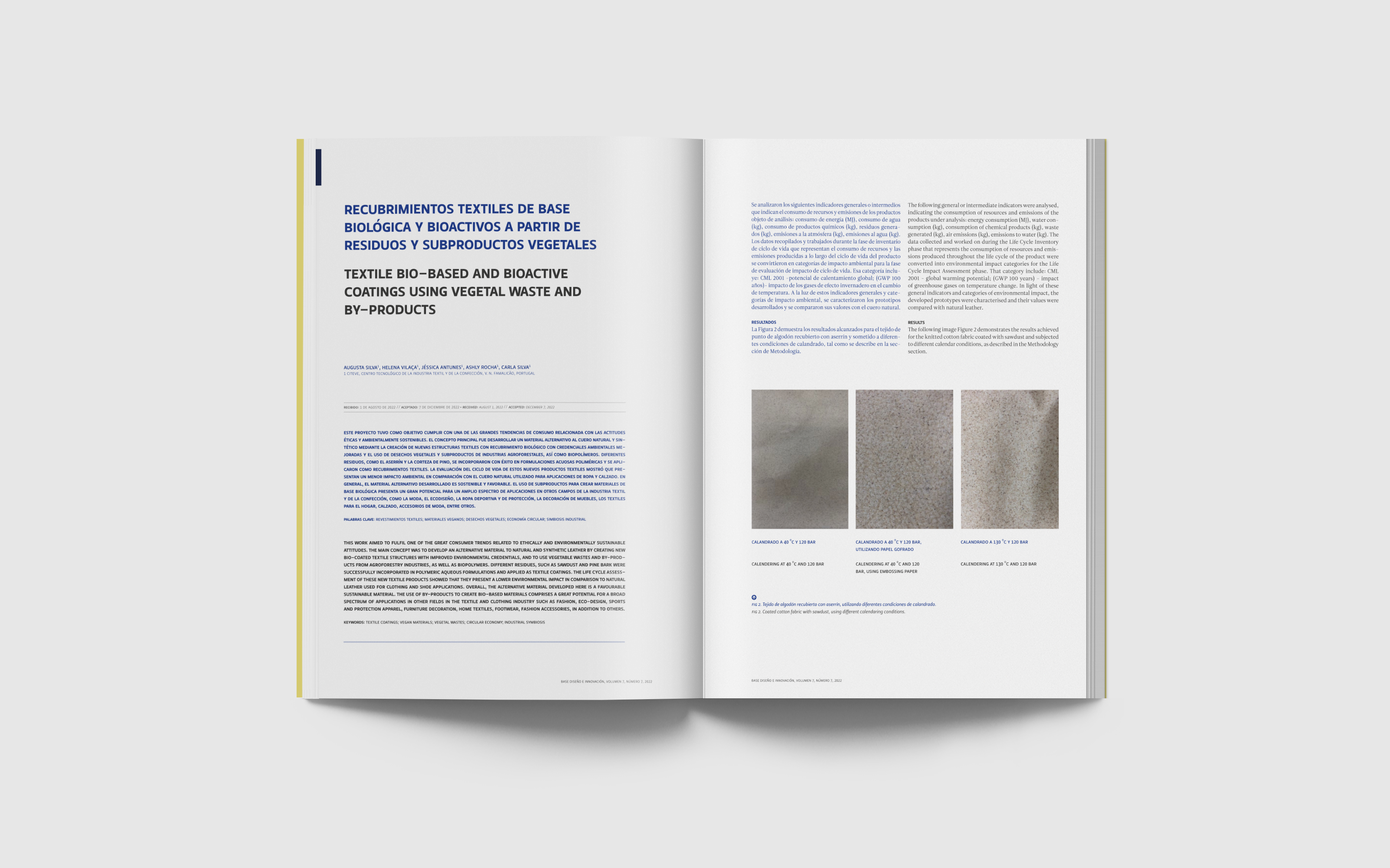Recubrimientos textiles de base biológica y bioactivos a partir de residuos y subproductos vegetales
Contenido principal del artículo
Resumen
Este proyecto tuvo como objetivo cumplir con una de las grandes tendencias de consumo relacionada con las actitudes éticas y ambientalmente sostenibles. El concepto principal fue desarrollar un material alternativo al cuero natural y sintético mediante la creación de nuevas estructuras textiles con recubrimiento biológico con credenciales ambientales mejoradas y el uso de desechos vegetales y subproductos de industrias agroforestales, así como biopolímeros. Diferentes residuos, como el aserrín y la corteza de pino, se incorporaron con éxito en formulaciones acuosas poliméricas y se aplicaron como recubrimientos textiles. La Evaluación del Ciclo de Vida de estos nuevos productos textiles mostró que presentan un menor impacto ambiental en comparación con el cuero natural utilizado para aplicaciones de ropa y calzado. En general, el material alternativo desarrollado aquí es un material sostenible favorable. El uso de subproductos para crear materiales de base biológica presenta un gran potencial para un amplio espectro de aplicaciones en otros campos de la industria textil y de la confección, como la moda, el ecodiseño, la ropa deportiva y de protección, la decoración de muebles, los textiles para el hogar, calzado, accesorios de moda, entre otros.
Detalles del artículo
Citas
Ahmad Khorairi, A. N. S., Sofian-Seng, N. S., Othaman, R., Abdul Rahman, H., Mohd Razali, N. S., Lim, S. J., & Wan Mustapha, W. A. (2021). A review on agro-industrial waste as cellulose and nanocellulose source and their potentials in food applications. Food Reviews International, 1-26. https://doi.org/10.1080/87559129.2021.1926478
Coelho, L., Magalhães, A. I., Fernandes, S., Batista, P., Pintado, M., Faria, P., ... & Malgueiro, R. (2020). Innovation of Textiles through Natural By-Products and Wastes. In A. Körlü (Ed.), Waste in Textile and Leather Sectors. IntechOpen. https://doi.org/10.5772/intechopen.90014
Gaur, V. K., Sharma, P., Sirohi, R., Varjani, S., Taherzadeh, M. J., Chang, J. S., ... & Kim, S. H. (2022). Production of biosurfactants from agro-industrial waste and waste cooking oil in a circular bioeconomy: An overview. Bioresource technology, 343, 126059. https://doi.org/10.1016/j.biortech.2021.126059
Mahari, W. A. W., Waiho, K., Fazhan, H., Necibi, M. C., Hafsa, J., Mrid, R. B., ... & Sillanpää, M. (2021). Progress in valorisation of agriculture, aquaculture and shellfish biomass into biochemicals and biomaterials towards sustainable bioeconomy. Chemosphere, 133036. https://doi.org/10.1016/j.chemosphere.2021.133036
Mallakpour, S., Sirous, F., & Hussain, C. M. (2021). Sawdust, a versatile, inexpensive, readily available bio-waste: From mother earth to valuable materials for sustainable remediation technologies. Advances in Colloid and Interface Science, 295, 102492. https://doi.org/10.1016/j.cis.2021.102492
Meyer, M., Dietrich, S., Schulz, H., & Mondschein, A. (2021). Comparison of the technical performance of leather, artificial leather, and trendy alternatives. Coatings, 11(2), 226. https://doi.org/10.3390/coatings11020226
CML 2001 (n.d.). Description of the CML 2001 Method. Sphera https://gabi.sphera.com/international/support/gabi/gabi-lcia-documentation/cml-2001/
Thorenz, A., Wietschel, L., Stindt, D., & Tuma, A. (2018). Assessment of agroforestry residue potentials for the bioeconomy in the European Union. Journal of Cleaner Production, 176, 348-359. https://doi.org/10.1016/j.jclepro.2017.12.143
Zhang, C., Xue, J., Yang, X., Ke, Y., Ou, R., Wang, Y., Madbouly, S. A., & Wang, Q. (2022). From plant phenols to novel bio-based polymers. Progress in Polymer Science, 125, 101473. https://doi.org/10.1016/j.progpolymsci.2021.101473
Zhou, Q., Le, Q. V., Meng, L., Yang, H., Gu, H., Yang, Y., ... & Peng, W. (2022). Environmental perspectives of textile waste, environmental pollution and recycling. Environmental Technology Reviews, 11(1), 62-71. https://doi.org/10.1080/21622515.2021.2017000


